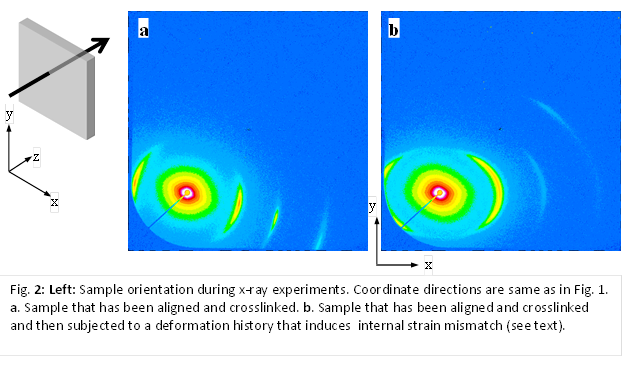Reports: ND753386-ND7: Buckling-Induced Morphological Transformations in Block Copolymers
Sachin Velankar, University of Pittsburgh
Over the past decade, there has been an explosion of literature on buckled thin films. The situation attracting most interest is of a thin stiff film bonded to a softer substrate. Upon compression, such a film buckles to and develops numerous wrinkles. Such wrinkled surfaces have numerous potential applications as smart surfaces with tunable adhesion, friction or wettability, flexible electronics, or mechanical tunability. The overall goal of this project is to translate this research to the bulk. Specifically, we seek to transplant the knowledge of the buckling of single thin films to the buckling of multilayered systems with the goal of developing buckled materials which show unusual mechanical properties.
The primary systems selected for study are block copolymers that self-assemble into layered or cylindrical morphologies. With suitable thermomechanical history, it is possible to induce an internal stress in such a structure such that the lamellar (or cylindrical) domains of one of the blocks are under compressive stress. The hypothesis is that under suitable compressive stress, buckles will appear. Experiments are being conducted using a commercial triblock styrene-butadiene triblock copolymer (SBS) copolymer with a morphology consisting of polystyrene cylinders in a polybutadiene matrix. As per the original proposal, we seek to align and crosslink these samples, and then subject them to the following thermomechanical history: (1) heat to 130C (2) stretch 30-100%, (3) cool to room temperature, and (4) release. This process is expected to induce a strain mismatch between the polybutadiene matrix and polystyrene cylinders which causes compressive stress on the polystyrene cylinders. If the compressive stress is sufficiently large, buckling is expected, which would be tested by small-angle x-ray scattering (SAXS) experiments.
We have successfully developed the procedure for alignment (Fig. 1a) and for crosslinking the samples. Crosslinking and alignment have been validated by swelling measurements (swelling in toluene reduced with increasing crosslinker loading), and by tensile testing (modulus increased with swelling, and was higher in the alignment direction as compared to perpendicular direction, Fig. 1b). SAXS experiments have been initiated in collaboration with Prof. Wesley Burghardt of Northwestern University using the SAXS beamline at the Argonne National Laboratory. Fig. 2 shows some preliminary results. Fig. 2a illustrates the scattering of the sample that was crosslinked and aligned, but no further mechanical deformation applied. The pattern is typical of an aligned sample, and the locations of the peaks are in a (1):(30.5):(70.5):(90.5 ) ratio typical of a cylindrical morphology. Fig. 2b illustrates a sample that was subjected to the deformation history mentioned above. Two differences are immediately evident: (1) there is a much larger azimuthal spread in the scattering intensity with an ellipsoidal pattern suggesting that the periodicity changes with azimuthal position, and (2) the third order reflection is at a large azimuthal angle. These SAXS results are still preliminary and additional experiments are in progress, but the results indicate that the deformation history applied can induce structural transformations in aligned SBS polymers. Whether the target morphology of buckled cylinders is realized will be revealed by further experiments.
In summary, in the first year of this project, we have laid the groundwork of sample processing and characterization. In the second year, many more experiments will be conducted first testing reproducibility, then developing the real-space structure that is consistent with the scattering pattern, and then quantifying the effect of stretching strain on the structural characteristics. We also aim to conduct in situ scattering experiments of the deformation process using the equipment developed by Prof. Burghardt.
In parallel with the investigation of block copolymers, we
have also initiated studies of buckling in layered systems that have been
created not by self-assembly, but by “forced” assembly. Fig. 3 illustrates an
example: an 860














